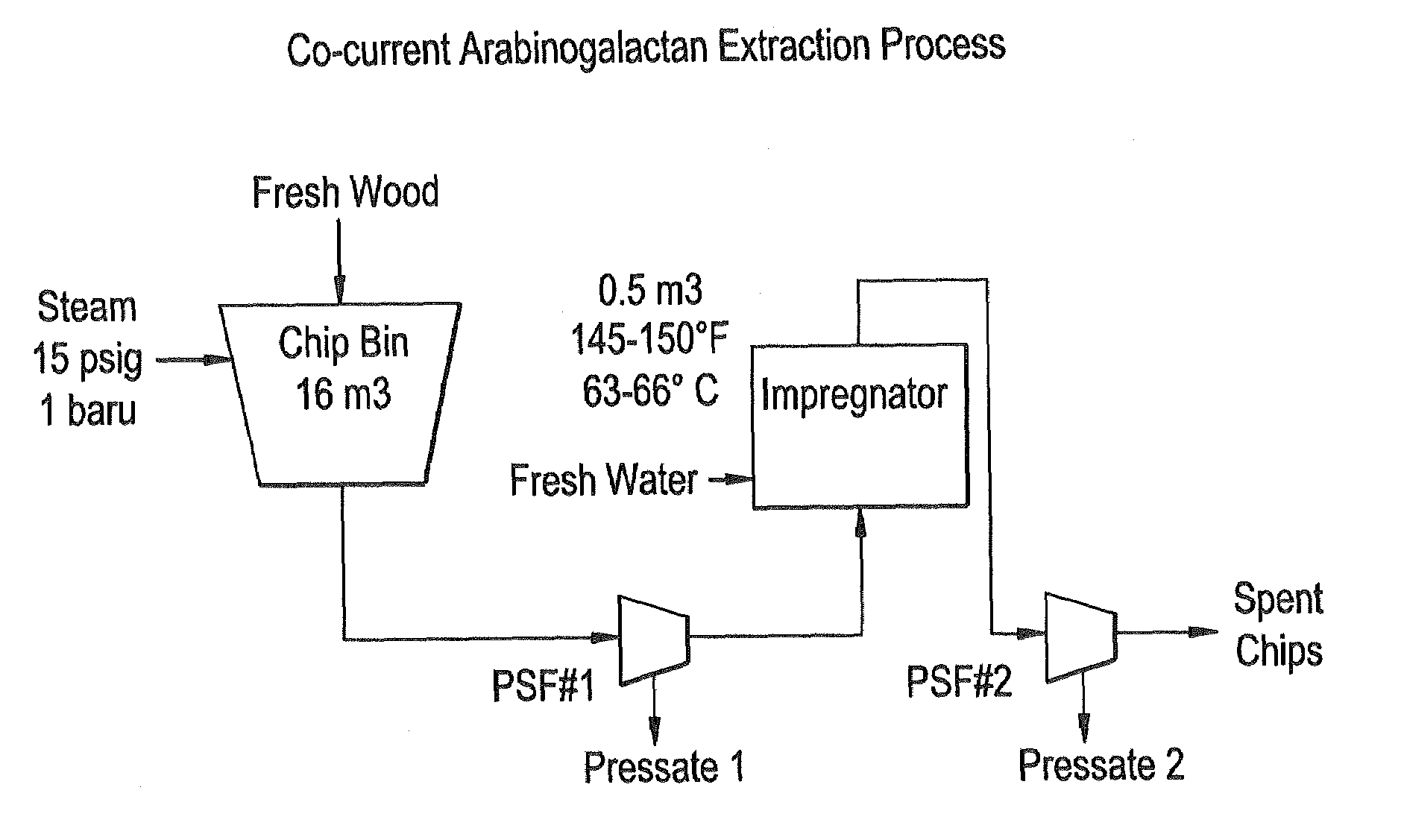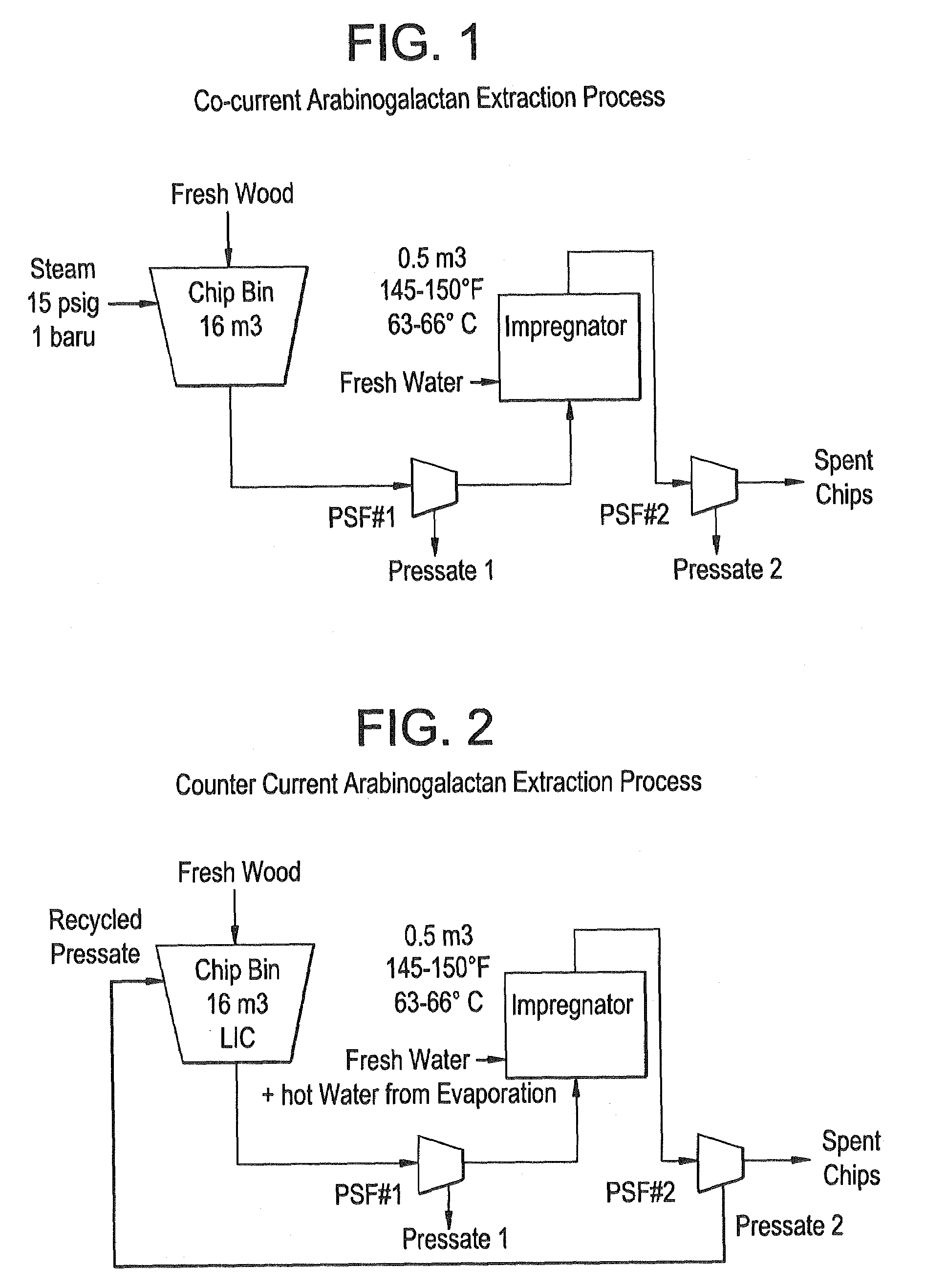Method for recovering arabinogalactan (LAG) from fibrous natural plant materials
a natural plant material and arabinogalactan technology, applied in the field of recovery of arabinogalactan (lag) from fibrous natural plant materials, can solve the problems of significant lag in the stream of spent wood chips, a significant amount of energy required to remove excess water, and only moderate yield, so as to reduce water consumption, reduce lag yield, and efficient and economically recover arabinogalactan
- Summary
- Abstract
- Description
- Claims
- Application Information
AI Technical Summary
Benefits of technology
Problems solved by technology
Method used
Image
Examples
example 1
[0044]An initial screening design of experiments (DOE) was performed. The DOE examined the effects of fresh impregnator makeup water temperature and residence time on the LAG and phenolic yield and the LAG concentration in the collected extract.
[0045]Variables for the 1st extraction trial:[0046]1. Temperature of Makeup Water (−1 / 0 / +1) 90° F. / 120° F. / 150° F.[0047]2. Residence Time in chip bin controlled by PSF Speed (−1 / 0 / +1) 20% / 30% / 40% motor speeds equal 13 rpm, 19 rpm and 26 rpm actual screw press speeds.
[0048]Set-Parameters for 1st extraction trial:[0049]1. Water to Used Chip Ratio ˜0.9 leading to the corresponding Impregnator Level of 50%[0050]2. Chip Bin Level (80% of maximum)[0051]3. Eastern Larch chips ˜1″×1″×⅛″
[0052]The DOE design for the trial was a three level full factorial plan with center points to find the optimal conditions. Table I shows the run order of the experimental variables in the trial. Experiments were randomized in order to remove effects from natural LAG c...
example 2
[0059]The second counter current extraction trial consisted of three runs: (i) a control run, (ii) a counter current run under optimal conditions and (iii) a counter current run with high temperature extraction to maximize phenol extraction. The control run was the standard co-current extraction operation. Optimal conditions for the counter current run are defined as 30% screw speed, 10 gpm fresh water make-up / recycle rate, & 120 Deg F. make-up water. In the original trial the optimal operating conditions yielded a 6.4% LAG solution. The high temperature run uses the same processing conditions as the optimal counter current design but increases the recycle stream temperature to 160-170° F. The recycle stream temperature was increased by raising the impregnator fresh water feed temperature and adding a steam heat exchanger to the recycle loop from plug screw feeder #2. Previous work from the first counter current extraction trial indicated that increased extraction temperatures lead ...
PUM
| Property | Measurement | Unit |
|---|---|---|
| freezing point | aaaaa | aaaaa |
| temperature | aaaaa | aaaaa |
| temperature | aaaaa | aaaaa |
Abstract
Description
Claims
Application Information
 Login to View More
Login to View More - R&D
- Intellectual Property
- Life Sciences
- Materials
- Tech Scout
- Unparalleled Data Quality
- Higher Quality Content
- 60% Fewer Hallucinations
Browse by: Latest US Patents, China's latest patents, Technical Efficacy Thesaurus, Application Domain, Technology Topic, Popular Technical Reports.
© 2025 PatSnap. All rights reserved.Legal|Privacy policy|Modern Slavery Act Transparency Statement|Sitemap|About US| Contact US: help@patsnap.com


